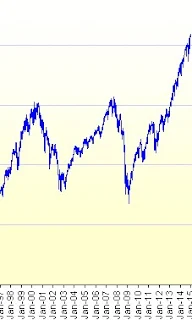 |
| US Equities. |
When investing, simply allocate the same number of dollars every month and buy the stocks/bonds regardless of the price.
When the price of stocks is low, you will automatically buy more shares. When the prices are high your set amount will buy fewer shares.
At the end of a long period of time your average buying price will be lower than the average price for the asset (for the time period) because you bought relatively more shares when prices were low and fewer when prices were high.
This should sound familiar if you ever had a financial advisor. Dollar-Cost-Averaging is session number five.
On the selling end
As pretty as Dollar Cost Averaging is on the buying end, it is ugly on the selling end.
Organizations like pensions pay out set amounts every month regardless of whether the market is high or low. That is Dollar-Cost-Averaging in reverse.
That is different than you as a private investor. You usually have the option of withdrawing less from an investment when your assets take a beating. Consider Harry's Place on the west side of Lansing. The owners did not take a dime out of the business for TWO YEARS when they experienced the one-two punch of the factory across the street closing down on top of the Great Recession.
This is not news to pension managers. That is why they showed a preference to bonds. Bonds don't return as much as stocks but investment grade bonds have less volatility. That worked fine until Greenspan goosed the market by lowering rates.
Pension managers were behind the curve. They were forced to chase return by investing in stocks.
The three largest domestic pensions, Calpers, Calteach and NYScommon are all 50% invested in equities, that is, stocks.
 |
| Calper asset allocation |
 |
| Calteach asset allocation |
If it is not abundantly clear, the pension funding crisis did not go away. They are still underfunded. The more juiced up with equities the pension is, the more vulnerable it pension to the amplification of loss due to dollar-cost-averaging on the selling side of the transaction. Most projections are unduly optimistic because they use AVERAGE rates of return and that method does not comprehend how dollar-cost-averaging is different than average prices.


No comments:
Post a Comment
Readers who are willing to comment make this a better blog. Civil dialog is a valuable thing.